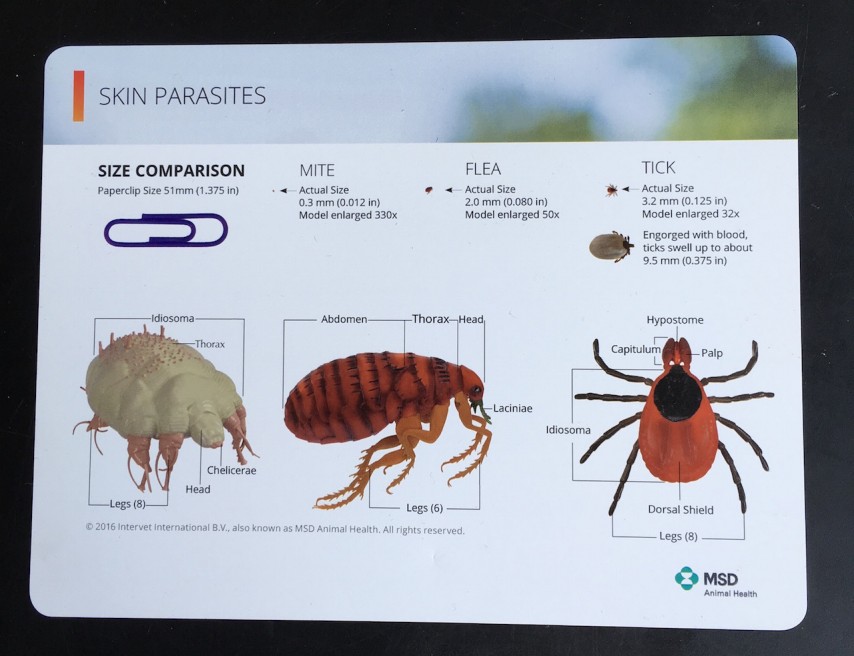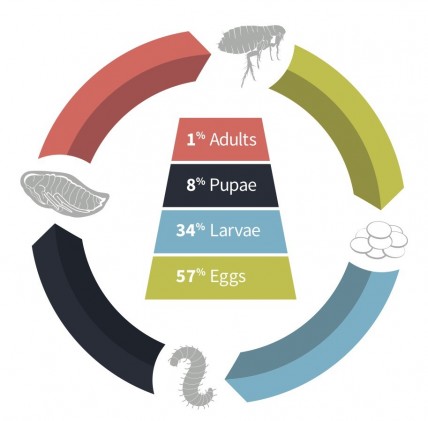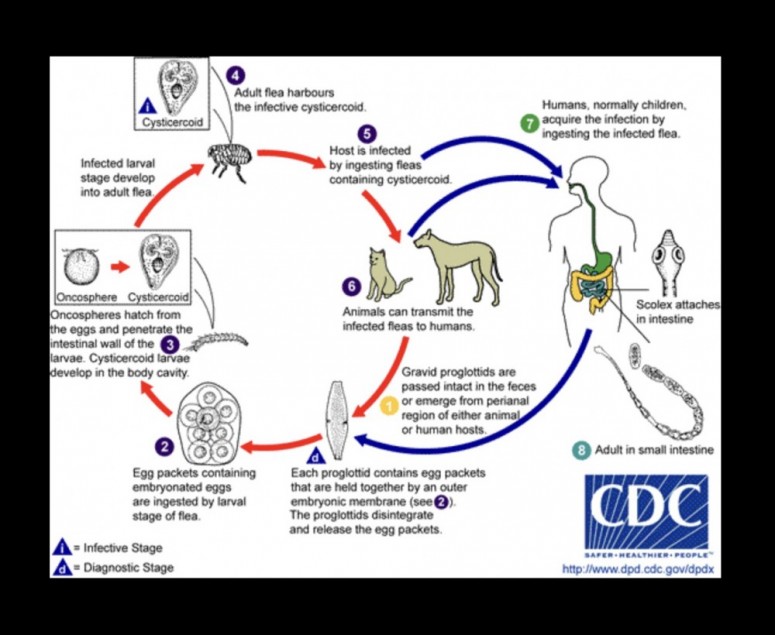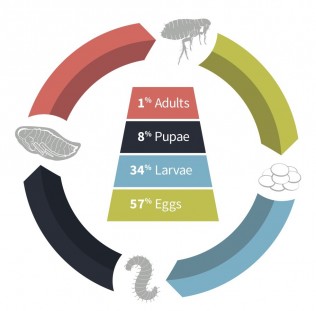Flea Control
FLEAS - "The not so hidden enemy" !!

Why are we seeing more flea problems with our pets? Part of the reason is our houses have become ideal environments for fleas to thrive, but also as our climate mellows there has been a national rise in the flea population and they have become a year round problem.
The flea life cycle is complete within 2-8 weeks, depending on the environment, with 95 degrees F and about 70% humidity ideal. Adult fleas remain on their host with eggs being laid and dropping off the host. A female flea will start laying eggs 24 to 48 hours after its first blood meal. As stated the eggs drop off into the environment and will hatch into larvae in 1-6 days. This larval stage lasts 2-3 weeks. Both eggs and larvae can be seen in the environment without magnification. The next stage involves the formation of a cocoon in which they pupate to subsequently develop into adult fleas after 1-2 weeks in ideal conditions. They emerge in response to vibrations, carbon dioxide and heat of a new host. If the conditions are not ideal they can survive up to 210 days in the cocoon, protected from most insecticides. Newly emerged fleas can survive up to 12 days in a moist environment before requiring a blood meal. A single female flea can lay between 200-300 eggs in her life time!
The source of fleas is almost entirely from the environment, with virtually no pet to pet transmission. Once a flea has found a suitable host it is reluctant to leave a good blood meal!

The cat flea (Ctenocephalides felis) is the commonest flea found on our pets and despite its name is found on dogs and cats. The name is merely because it was first discovered on a cat!
Fleas affect our pets and ourselves in many ways. Flea infestation causes dogs and cats to itch but if they are allergic to the flea saliva then the itch can be particularly severe even with small numbers of fleas. Atopic animals ( allergic to environmental allergens ) are particularly prone to this reaction. Severe flea infestations can cause anaemia. Fleas will also cause itching in people, with the ankles being a common site for bites.
Fleas can be vectors for diseases. The tapeworm Dipylidium caninum is spread by animals eating affected fleas. The presence of this tapeworm indicates poor flea control. Prevention needs adequate flea control. In very rare cases humans, mainly children can be infested with the tapeworm, by accidentally ingesting the flea.

Fleas also transmit Mycoplasma haemofelis to cats, bacteria that attach to the surface of red blood cells, damaging the cells causing anaemia. The disease can be very severe and life threatening. The mycoplasma is present in adult fleas, larvae and flea dirt. A ricketsial disease Ricketsial felis has been identified in 6-12% of cats, and could be spread by fleas, although this has not been proven. The organism can be spread to humans, causing a rash, headaches, fever and myalgia.
Domestic cats are reservoirs for Bartonella henselae, the cause of bartonellosis or cat scratch fever in cats and people. Bartonella is spread from infected cats to other cats and people when breaks in the skin (e.g. scratches, cuts, wounds) are inoculated with flea faeces (poo) infected with the bacteria. Cats may have fever, enlarged lymph glands and be lethargic. People may exhibit low-grade fever, regional lymph node enlargement and general malaise. More severe signs may be seen in people with compromised or immature immune systems, including signs like chronic fatigue, headaches, blurred vision, inco-ordination, inflamed eyes (uveitis) and infected heart valves. As can be seen flea control / prevention is very important for both people and pets.
If a flea infestation is suspected fleas and flea dirt may be identified in dog’s and cat’s coats. This is aided by using a flea comb. Flea dirt appears as dark brown particles in the coat and when these are applied to wet cotton wool or paper towel, when they will turn red brown. Sometimes flea larvae can be seen in the environment and bedding. Owners may have bite marks.
How often should flea products be used? Fleas are ubiquitous in the UK and are present all year round, so flea prevention should be applied all year for control. Checking for the presence of fleas by looking through the coat or using a flea comb is a fire fighting approach, and by the time fleas are seen the home will have become infected. TOO LATE. Therefore constant use of flea products offers the best approach for prevention.
If there is already a flea infestation then the approach should be as follows:-
1. Use of an effective adulticide, with rapid onset, on all the animals in the house.
2. Use of an environmental insecticide
3. Use of an environmental insect growth regulator
4. Cleaning the environment, vacuuming the house daily and washing the pet’s bedding in a hot wash (at least 60 degrees centigrade)
It is important to realise that because the predominant part of the infestation will be in the environment, it will be at least 12 weeks before control can be achieved, even with the best protocol!

So as stated, prevention is best. However even in well controlled regimes the occasional flea may be seen at peak times but they should not establish themselves in the house. The following is an advised approach to flea prevention:-
1. Use of an effective adulticide on all the animals.
2. Use of a combined insecticide and insect growth regulator in the environment
Considerations in choosing an adulticide:-
1. Need 100% adult flea kill
2. Need rapid onset, especially if an animal is allergic to fleas.
3. Need adequate duration of action
4. Decide if prefer a systemic (internal) or topical / spot on preparation
5. Need a product licenced for the species being treated
6. A product that can be used easily by owners
Many environmental sprays are available but should contain an insecticide along with an insect growth regulator that prevents the development of the larvae.
What are the common reasons for failure:-
1. Swimming / shampooing which removes topical products
2. Insufficient frequency of application or dosing
3. The level of challenge (effective control just overwhelmed by vast numbers of fleas)
4. Compliance of pet owners – THIS IS THE COMMONEST!
So far there have been no proven cases of drug resistance, although owners report this.
As can be seen, expert advice is essential to design the best protocol for flea control. So often, money is wasted buying products online or from pet product suppliers that is not accompanied by professional advice. All our products come with the availability of complimentary professional advice. Most failures are caused by poor advice and unrealistic expectations.